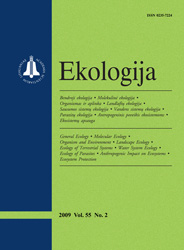 ISSN 0235-7224 ISSN 2029-0586 (online) |
2008 m. Nr. 2 Ecological assessment of agrotechnical measures in sandy light loam soils
Potato as the most widespread agronomic culture was used for assessment of soil compaction caused by the new ecological farming technologies. The experiment was carried out in 1998–2007 growing potatoes in a sandy light loam soil. The influence produced by different types of tractors (traction classes 6 and 14 kN) used for potato planting and the care of potato crops on soil compaction in the technological tracks and ridges was compared. The experimental technology was based on the use of a cultivatormulcher with the horizontal rotor whose symmetrical axis is perpendicular to the direction of movement. It was compared with the traditional technology when the soil ploughed in autumn is cultivated and harrowed in spring before potato planting and later when potato haulms are stalking. The compared parameters included the influence of mulching and repeated driving of tractors on physical soil properties in the tracks: density, hardness, compaction level, fractional composition and the crumbling index. The structure of the study soil was seriously damaged by aggregate carriers. After three drives, soil density in tracks approached the limit value suitable for plant cultivation (1.6 g/cm3). The compaction level in the 16-cm surface soil layer increased 1.10–1.65 times. In deeper layers, its value quickly approached 1. As a result, the physical degradation and cultivation resistance of soil as well as energy input for soil cultivation increased. The environment was increasingly polluted with exhaust gases. Therefore, the ecological experimental technology of potato growing requires reducing the number of drives between the rows. Applying the common technology, the soil crumbling index reached 78.5% using the tractor T-25, and 82.9% using the tractor MTZ-82. Applying the experimental technology, these indices were 73.0% and 78.7% respectively. The potato plant mass grown applying the traditional technology and using the T-25 tractor (with narrower tyres) was by 30.2% larger than the plant mass grown using the MTZ-82 tractor (wider tyres). In the mulched soil with a lower compaction value, the potato plant mass was even by 46.1% larger. Keywords: soil properties, potato, technologies, forecrops, mulching, tractors, energy input |
Issues:
2011 - Vol.57 No. 1, No. 2 2010 - Vol.56 No. 1-2, No. 3-4 2009 - Vol.55 No. 1, No. 2, No. 3-4 2008 - Vol.54 No. 1, No. 2, No. 3, No. 4 2007 - Vol.53 No. 1, No. 2, No. 2.priedas, No. 3, No. 4 2006 No. 1, No. 2, No. 3, No. 4 2005 No. 1, No. 2, No. 3, No. 4 2004 No. 1, No. 2, No. 3, No. 4 2003 No. 1, No. 2, No. 3, No. 4 2002 No. 1, No. 2, No. 3, No. 4 2001 No. 1, No. 2, No. 3, No. 4 |